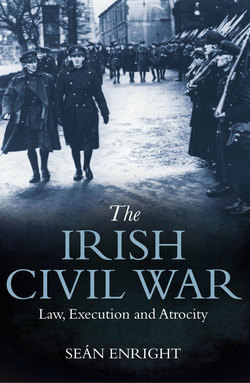Читать книгу The Irish Civil War - Seán Enright - Страница 9
На сайте Литреса книга снята с продажи.
ОглавлениеAuthor’s Note
It was the worst possible start for a small state that had just secured a measure of independence. After the death of Collins, the new commander in chief of the National Army, General Mulcahy, urged his men not to retaliate, and, on the anti-Treaty side, Liam Lynch also urged his men to adhere to recognised standards of warfare. Both sides fell far short of this ideal.
The war was a complex and multi-layered event that cannot be recorded in a single volume and this book deals only with one dimension – deaths in custody of the state. By focussing on the execution policy and the fate of prisoners killed in custody, it should not be thought that the death and suffering of so many others is considered less important or not highly relevant to the context in which these events took place. One distinguished historian has argued that all that took place allowed the losing faction to assert ‘victimhood’ and the full context of all that took place should be acknowledged.1 The anti-Treaty forces perpetrated killings that still shock. Not just civilians shot in the crossfire but during attacks on the National Army in Dublin that sometimes showed a reckless disregard for civilians. Others were killed in the flood of robberies that overtook the country although not every robbery or even most robberies can be safely ascribed to the anti-Treaty faction.
The attacks on the railways also claimed the lives of civilians: the Liscahane train derailment is an example. At Ballyconnell, a column of anti-Treaty fighters killed two civilians, wounded a third and left a trail of arson and robbery in their wake before disappearing into the hills. There were also occasional killings of unarmed national soldiers on leave like National Army Private Denis McCarthy who was shot in the back as he was taking leave of his wife, and the assassination of Commandant Peter Doyle at Wexford Cathedral. In a final category was the occasional shooting of prominent or outspoken Free State supporters like Old Doctor Higgins, the Coroner of King’s County. This perhaps gives the flavour of events, but what follows is not a comparison of the conduct of both sides.
This book explores the execution policy and unauthorised killings in custody which were closely connected. It examines how a climate emerged in which prisoners could be tried by rudimentary military courts and then executed, how so many other prisoners were killed without any trial and why so much of what took place was simply blanked out of the public consciousness.
